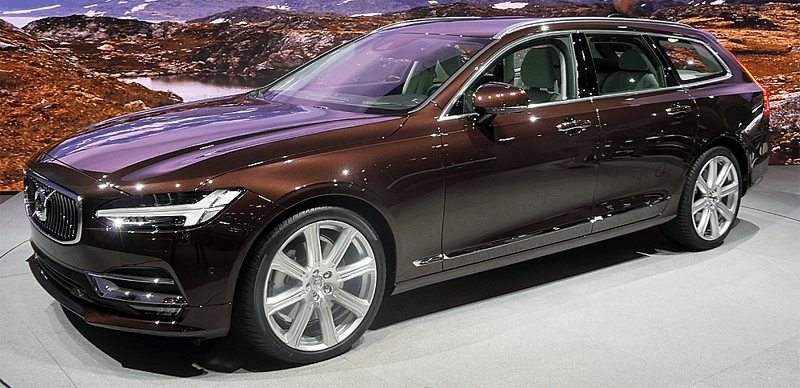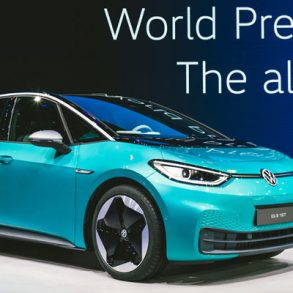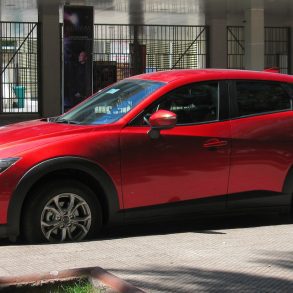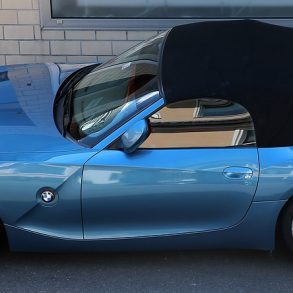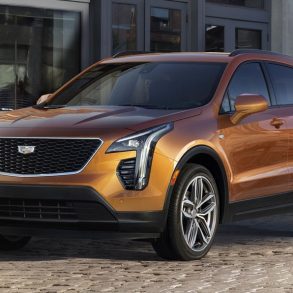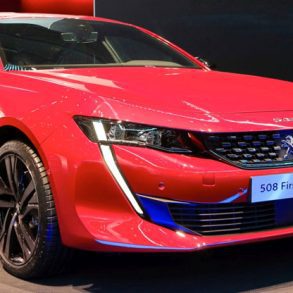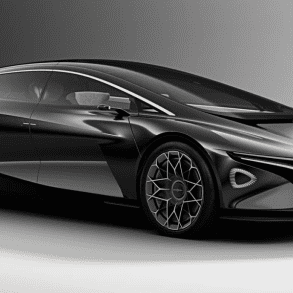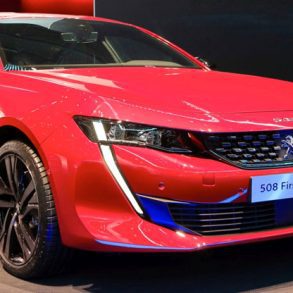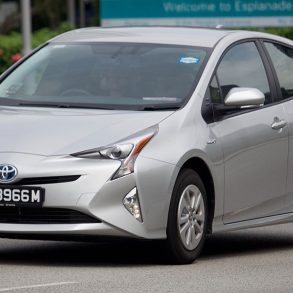-
Lamborghini Centenario
So Lamborghini claims to have developed the Centenario to celebrates the 100th anniversary of the brand’s founder Ferruccio Lamborghini, but they’d better just admit that it really is a farewell tribute to the departuring CEO Stephan Winkelmann who has saved the company from extinction in his 11-year tenure at the brand. Winkelmann has turned a struggling, low-volume money-pit into a successful cashcow, which produces more supercars than ever and is preparing to launch a third model line with an über-SUV in two years time, which will undoubtedly rake in more cash. But the insane looking, all-out special editions launched under Winkelmann’s watch are what both boost the brand image and bring in the cash: the Veneno, the Sesto Elemento, the Reventon. And now the Centenario: a 770 hp, naturally aspirated V12 engine launches the carbon-bodied Centenario to 300 km/h in 23,5 seconds and doesn’t stop until 350 km/h. All 40 (20 coupes and 20 roadsters) have already been sold out at € 1,75 million a piece, before taxes.
-
Lexus LC 500h
Lexus stunned the world when it showed the concept car-like production version of its LC500 Coupe in Detroit last January. In Geneva the brand debuts the hybrid version of the new luxury coupe. It’s equipped with the next-generation Lexus Hybrid Drive technology, called “Multi-Stage Hybrid”, promising higher performance and efficiency. Combining a 3,5 liter V6 petrol engine with an electric motor gives a combined 354 hp of power, sent to the wheels through a four-speed gearbox. Despite Lexus’ claims, expect this car to be closer to a GT than to a thoroughbred sports car.
-
Maserati Levante
Maserati is pulling a Porsche Cayenne-move, launching its first luxury SUV in order to multiply its production volume and fatten its profits. The new Levante will arrive in showrooms this spring and borrows its engines from the Ghibli sedan: 3 liter twin-turbo V6 petrol and diesel power plants, although the future may hold a plug-in hybrid as well. Other mechanical underpinnings are known from the Jeep Grand Cherokee, but the body is all aluminum to give the Levante some of the characteristic Maserati-dynamics.
The design may take some getting used to, but that never withheld the Cayenne from becoming hugely successful, and at least it’s recognizable as a Maserati with the long, grooved hood, sleek side windows and large typical grille with vertical chrome bars and a prominent logo. The rear wheel arches are very prominent and from the rear three-quarter view actually reminds me of the second-generation Cayenne. The interior is as luxurious as we’ve come to expect from the brand, just like it is exactly one step too ostentatious to be called stylish. But I like it.
-
McLaren 570GT
McLaren’s Sports series gets a third model next to the 570S and 540C: the 570GT which will be the practical sports car of the British brand. It will have a softer suspension for more comfort and a trunk that will fit 220 liters of luggage under the glass “Touring Deck”, giving the 570GT a combined 350 liters of boot, together with the frunk (front trunk). The familiar 3,8 liter twin-turbo V8 is also still mounted in the rear, and the specs are similar to those of the 570S: 570 hp, 600 Nm of torque, 3,4 seconds from 0 to 100 km/h and 328 km/h top speed. I love the high-tech dashboard and McLaren’s design language is starting to grow on me, I first found it a bit too computer-generated.
-
Mercedes-Benz C-Class Convertible
This is the first time that Mercedes builds a convertible version of its C-Class, although the previous generation E-Class convertible was built on the W204 C-Class platform. This is the fourth convertible in Benz’ line-up, together with the SLK-come-SLC and SL roadsters, and the top-of-the-line S-Class Convertible. Well, technically you can also still buy the E-Class convertible but why would you? This C-Class basically replaces it. We’re just waiting for Mercedes to tell us they’re working on a GLE Convertible SUV, just make sure every niche is covered. Okay, maybe we’re not exactly waiting for it but I wouldn’t be too surprised if they actually did build it, even though the Nissan Murano CrossCabriolet was a total flop.
The design of the C-Class Convertible shouldn’t surprise anybody, as it is in line with that of the C-Class Coupe and that also makes a soft-top the logical choice. A hard-top convertible would make a coupe largely superfluous. The fabric top will be available in four colors and can open or close in 20 seconds, even when driving up to 50 km/h. Mercedes is known for its ability to make driving with the top down as comfortable as possible, and it proves it again with familiar features like the “Aircap” spoiler on the top of the windscreen to deflect the wind away from the passenger’s heads, and if they still feel a bit cold there’s the “Airscarf” breathing warm air in their necks.
- Mercedes-AMG C 43 Coupe & Convertible
Mercedes also revealed the mild-AMG version of the C-Class Convertible as well as the Coupe with the Mercedes-AMG C 43. For those who find the 476 hp of the C 63 a bit over the top, the 3 liter V6 twin-turbo engine delivers 367 hp and 520 Nm of torque. It sprint to 100 km/h in 4,7 seconds and is – of course – limited to 250 km/h. Four-wheel drive is standard, as is the nine-speed automatic gearbox. It looks like a real AMG, which means some will find it way over the top, and I personally would never be able to live with myself for missing out on the best sounding engine in a mass production car, so I’d continue saving for the C 63. Not that 367 hp is weak, but that V8 sound is just spine shivering.
-
Mercedes-Benz E-Class
All I’m going to say about this car is this: at the Volkswagen stand it’s difficult to see which cars are new, because they look exactly like the old ones, but at the Mercedes stand I got confused at which car I was looking at: the C-Class, S-Class or the new E-Class. I even found myself taking pictures of the C-Class while thinking this was the new E. Facepalm…. for Mercedes-Benz.
-
Morgan EV3
An electric car from Morgan, the company that still uses wood to build a frame for a car, perhaps the most conservative carmaker in the world? As paradoxical that may sound, it gets even crazier when you see which of their models they’ve selected to be turned into the company’s first-ever EV: the Threewheeler. The archaic V2 mounted all the way on the front of the nose is replaced with a modern electric motor. The EV3 isn’t only the first Morgan with an electrified drive train, it’s also the first Morgan with a carbon fiber composite body work. As a result, the electric threewheeler weighs just 500 kilograms. A 20 kWh batterypack gives the EV3 a range of 240 fun-filled kilometers. The low weight also means that a 62 hp electric motor is enough to launch the car from 0 to 100 km/h in 9 seconds and a top speed of more than 145 km/h, if you dare. Morgan hasn’t said when it enters production but when it does, I’d love to get into one and drive it.
nanoFlowcell Quantino
nanoFlowcell’s science sounds too good to be true, and considering Nunzio La Vecchia has failed to convince most other engineers of this revolutionary battery system, may very well be too good to be true. But that would be a shame, as the cars he designs are absolutely gorgeous. Last year the company showed the Quant F in Geneva, this year it is accompanied by the Quantino, a small and cool looking two-door coupe-hatchback crossover. On its website, nanoFlowcell claims the Quantino has a range of more than 1.000 kilometers on a single tank of electrolytes, supported by their claims of a 14-hour non-stop endurance test drive, “after which its two 159 liter tanks were still at 78 percent of their initial fueling level.” The electrolytes are said to be non-toxic and non-flammable, but an infrastructure would have to be created if the technology delivers on the company’s promises. And if it does, hydrogen fuel cells would be gone, and so would recharging times for battery electric cars. I remain skeptical of the technology but enthusiastic of the designs.
-
Porsche 911 R
So you thought Porsche has gone soft and entirely switched to turbocharged engines and automatic gearboxes? They just proved you wrong with the 911R, the lightest 911 of the current generation at 1.370 kilograms, another 50 kg off the GT3 RS. They share the same engine, a 500 hp flat-six, but the R loses the extreme spoilers of the GT3 RS. It does have ceramic brakes as standard, as well as a manual gearbox. Porsche is a champion of charging customers more for less content, and the 911R is the latest example. Still, at a limited production of less than 1.000 units, the R will be sold out in no time. I’m just glad they came to their senses about the turbo and the manual, but I sincerely hope it isn’t a last goodbye, no matter how good the PDK shifts and how great the 997.2 drives.
-
Renault Megane Estate
The new Renault Megane hatchback is barely in showrooms, but the French are already pushing forward with the station wagon version. The rear of the Estate closely resembles the design language of the larger Talisman Estate with the rear lights extended into horizontal bars running almost to the center logo. The station wagon has a stretched wheelbase, but is for the rest technically similar to the hatchback, which also means the GT version is the first station wagon in the compact segment to feature four-wheel steering. At low speeds, the rear wheels turn the opposite way to make tighter turn-ins possible for easy parking. At higher speeds, the rear wheels turn in the same direction as those in the front (although not as far obviously) to improve directional stability. Despite this dynamic character, practicality is not forgotten: the huge trunk can stow 524 to 1595 liters of luggage. This will be the volume maker of the Megane range, which is likely to be complete with the hatchback and the Estate. A coupe is just too low-volume to be financially responsible for Renault.
-
Renault Scenic
Renault has unveiled the new Scenic MPV at the Geneva Auto Show, and the fourth generation of the model that started the popular segment 20 years ago is becoming funkier than the outgoing, somewhat tame predecessor. The line that runs along the bottom of the side windows is crooked and turns into the C-pillar in a most original way, reminding of the 2011 R-Space concept car. The windshield runs almost seamlessly runs into the visually floating roof thanks to the black pillars. The lower part of the doors and the nose are now familiar Laurens Van den Acker design elements, as seen on all recent Renault designs. The increased wheelbase offers more interior room and the second-row seats can fold completely flat, but for who needs even more space, Renault is expected to launch the new Grand Scenic at the Paris Auto Show this fall. I love how they’ve made the MPV look cool again, without having to turn it into a crossover. The 20-inch wheels that come standard also help, something that Alfa Romeo should’ve considered for the Giulia. The practical and innovative interior design that made the Scenic so successful in the last decades are still in place, but now in a package that you’d actually want to drive a Scenic instead of having to buy it for its practicality and interior space.
-
Seat Ateca
It’s taken them a while, but the VW Group is allowing its Spanish subsidiary to finally move into the booming crossover business. The Seat Ateca will enter European showrooms this summer, and will share its genes with the Volkswagen Tiguan and an upcoming Skoda crossover. Built on VW’s modular MQB platform, the mechanics are largely familiar, but its Spanish design should set the Ateca apart from its platform siblings. The design follows the typical crossover style, spiced up with a handful of Seat design features like the trapezoidal grille and triangular light signatures. A sharp-edged belt-line and an original C-pillar design help it make its mark in the already crowded segment. Despite obviously being drawn according to the VW Group standard design language, Seat proves once again they’re allowed the most individuality and originality within that language, making the Ateca recognizable yet attractive. Seat is aiming for a 5% share of the segment, or about 60.000 annual sales, which would set it on par with the Skoda Yeti and Mazda CX-5, which doesn’t seem like an impossible task. That would also make it the brand’s third-best selling model after the Leon and Ibiza, so indeed an important launch for Seat. A smaller crossover is expected to follow in the future.
SsangYong Tivoli XLV
Just when you think SsangYong was on the right track stylewise, with the pretty good looking Korando and Tivoli, they come up with the Tivoli XLV, a totally disproportionate elongated Tivoli. A Belgian spokesperson from the brand recently said jokingly in an interview that SsangYong “has fired the blind designer”, but after he got a job at Toyota (see below), they must have hired his equally blind brother. It looks just as much an afterthought as the Renault Grand Scenic on the 2003-2009 Scenic II, or in commercial vans the Peugeot Partner L2, with its clearly visible welds where the extra piece of sheetmetal was inserted. And if it was to turn the Tivoli in the first 7-seater small crossover, at least there would’ve been a point to stretching the design beyond its aesthetic limits. The 24 extra centimeters behind the rear axle (the wheelbase is unchanged) are only used to give the second-row passengers slightly more room but mostly to increase the luggage space from 423 liters to 720 liters. Ugh, this hurts my eyes almost as bad as the Rodius.
-
Toyota C-HR
Toyota is working hard at becoming the new SsangYong of automotive designs. After the ghastly Prius, the Japanese now launch a crossover version of the Prius to compete with the Nissan Qashqai. Hybrid as it may be, the design is yet again a complete mash-up of lines, shapes and bad decisions. The C-HR concept car was a three-door and looked pretty cool but not very realistic. For the production version they decided to improve practicality and add a set of rear doors, while trying not to mess with the lines of the concept car. Well, the result is terrible: the “hidden” rear door handle is now almost in the roof, giving the impression of a three-door, except the proportions of the front doors don’t match with that idea. To enable the rear windows to roll down, an extra bar was added, which breaks the window lines in a terrible way. At least DS had the guts to just tell customers they sacrificed opening rear windows for the sake of style, if only Toyota had dared to do so. From the rear 3/4 I find the design plain hideous, just a confusing mess of lines and shapes. That’s too bad, because the car actually looks pretty good from the front, a bit aggressive yet relative clean look. Some say you should admire Toyota for having the guts to break away from the ordinary, but that doesn’t mean it’s attractive. Not boring doesn’t equal not ugly.
-
Volvo V90
At the end of next summer the new Volvo V90 will arrive in European showrooms, which will be the third model on the brand’s new SPA platform (Scalable Product Architecture), after the XC90 SUV and the S90 sedan. It will be launched with two petrol and two diesel engines, all turbocharged four-cylinders, linked to the familiar eight-speed automatic. In November the V90 T8 AWD will follow, with a four-cylinder petrol engine powering the front wheels and an electric motor on the rear wheels, giving a combined power output of 410 hp while using just 2,1 liters of fuel per 100 km. I love the clean yet original lines of the V90 (you hear that, Toyota?), one of my favorite designs on the show, and it has a huge boot (no exact figures released yet). The interior is similar to the S90, which means elegant and clean Swedish design. Volvo has a winner on its hands with this one.

